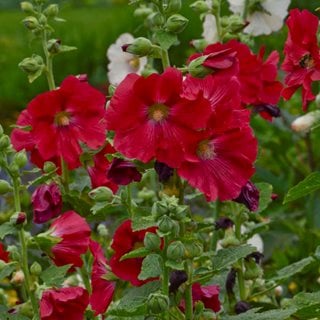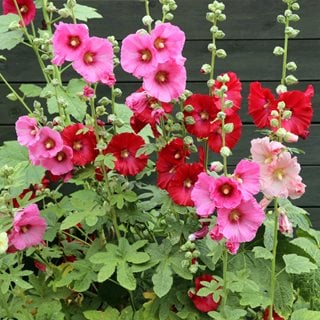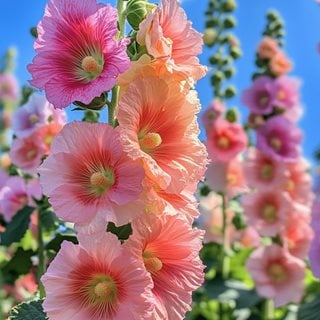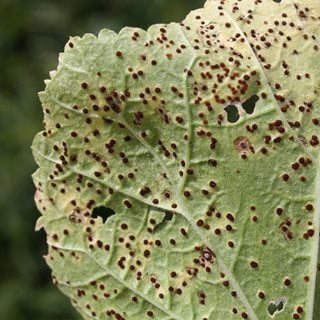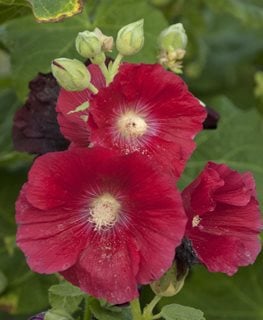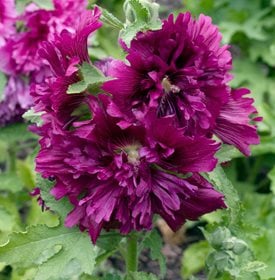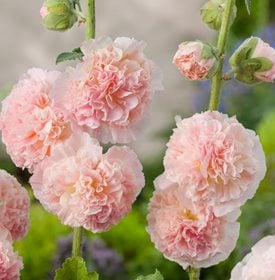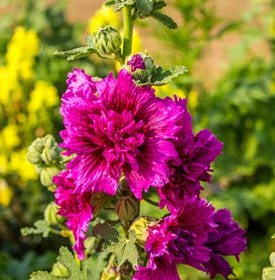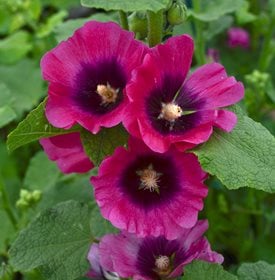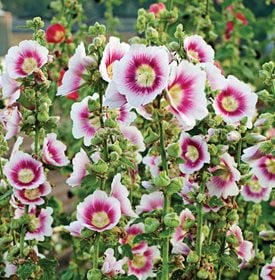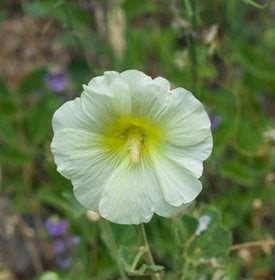HOW TO GROW HOLLYHOCKS
Planting and caring for this old-fashioned mid-summer bloomerA classic cottage garden staple, hollyhocks (Alcea rosea) bloom mid-summer with numerous flowers on tall spikes. Many of the most common varieties are biennials, meaning they complete their lifecycle over 2 years. The first year is spent growing foliage and storing energy. In the second year, the stalks shoot up, flowers bloom and seeds form. However, there are also many varieties that behave like short-lived perennials and will flower in their first year when planted early enough in spring or started indoors in winter.
Other than staking and cutting the stalks back after flowering, hollyhocks really don’t require much maintenance, but they do need to be protected from insects and fungal diseases such as rust. Hollyhocks support the lifecycle of painted lady butterflies as a host plant for their caterpillars and also attract other pollinators such as bees and hummingbirds. If you’ve got a cottage garden, it’s just not complete without a few hollyhocks gracing the edges.
On this page: Basics | Planting | Care| Common Problems & Solutions | Varieties | FAQs | Gardening with Hollyhocks
On this page:
- BASICS
- HOW TO PLANT HOLLYHOCKS
- HOLLYHOCK CARE
- COMMON HOLLYHOCK PROBLEMS & SOLUTIONS
- HOLLYHOCK VARIETIES
- GARDENING WITH HOLLYHOCKS
- FREQUENTLY ASKED QUESTIONS
HOLLYHOCK BASICS
Zones:
3-9
Height/Spread:
6-8 feet tall, 1-2 feet wide
Exposure:
Full sun to part shade
Bloom time:
June-August
Color and characteristics:
The single or double, cup-shaped flowers have little or no stalk and bloom on tall spikes. Hollyhocks come in a wide variety of colors: blue, pink, purple, red, white, yellow, and even black. The tall spikes are covered with blooms from top to bottom. Hollyhock leaves are large, coarse, and palmate in shape.
“It’s easy to overlook hollyhocks as pollinator plants, but they have lots of nectar and pollen, attracting bumble bees, hummingbirds, and butterflies. As for color, bumble bees seem to prefer white or pink petals, while hummingbirds favor deep reds and purples.”
— Master beekeeper Rusty Burlew, Honey Bee Suite
HOW TO PLANT HOLLYHOCKS
How and when to plant hollyhock seeds:
Hollyhocks can be started from seed indoors or out. Seeds can be sown directly outdoors about a week before last frost. Sow at just ¼ inch deep and about 2 feet apart. Hollyhocks have long taproots, so if seeds are started indoors, use tall, individual pots and transplant early to avoid damage. Start indoor seeds about 9 weeks before the last average frost date. Seedlings can be placed outside two to three weeks after the last frost. Also, bear in mind that some are biennials and may not bloom until their second year.
Where to plant:
Plant in a well-draining area with full sun to partial shade. Due to their height, protect from damaging winds and provide support such as a fence, wall, trellis or stake. Hollyhocks will readily self-seed if left to their own devices, so locate them in an area where this won’t be a nuisance. Also, hollyhocks are one of very few plants that can be planted in proximity to black walnut trees because they are tolerant of the chemical juglone that is leached into the soil by the tree.
“Hollyhocks can be tricky to start from seed. They are best to sow and forget, sometimes taking up to a year to sprout. But once you’ve got them, you’ll have them forever because they gently self-seed in places you least expect.”
— Professional flower farmer, Erin Benzakein of Floret Flower Farm. Take a walk through Erin's "hollyhock jungle."
HOLLYHOCK CARE
Pruning:
Individual hollyhock flowers can be removed when they fade and entire stalks can be cut back to the base after flowering. This will prevent seed heads from forming and reseeding. Although, if you’d like to have seeds set for next spring, leave the flowers and a few stalks until the seeds have dropped. They’ll die back in winter and all stems and leaves should be cut back to the ground to prevent rust disease from overwintering.
Soil:
Provide rich, moist, well-drained soil for hollyhocks.
Amendments and fertilizer:
Hollyhocks can benefit from a light application of fertilizer or compost in the spring.
Watering:
Provide regular water and keep soil moist for starting hollyhocks. However, once well established, they are fairly drought tolerant. Water from below and avoid wetting the foliage, as this can lead to diseased leaves.
Propagation:
Hollyhocks are best, and easiest, grown from seed and they will readily self-seed if flower stalks are left in place.
Over-wintering:
In areas that get hard freezes, hollyhocks can be grown as annuals, starting seeds in containers and over-wintering indoors. Water sparingly over the winter and gradually reintroduce them outside when the weather begins to warm up.
In other areas where they can be left outside, prune them back to about 6 inches above ground level in the fall. Cover with 4 to 6 inches of straw or mulch over the root zone and base of the plant. In spring, gradually remove in layers to slowly acclimate the roots. Once new growth is emerging, remove all the straw or mulch. Re-cover in case of a spring freeze.
“Once they're established, hollyhocks are pretty drought-tolerant, so they are perfect plants to grow here in North Texas (zone 8A) where we get dry and hot summers. Even in our hot climate, hollyhocks grow best when planted in full sun.”
— Dina Mills, Mills Family Gardening
COMMON HOLLYHOCK PROBLEMS & SOLUTIONS
Hollyhock rust (yellow spots and raised, rust-colored bumps on the leaves): The most common disease affecting hollyhocks. It appears as yellow spots on leaves, then develops into brown or rust-colored bumps on underside of the leaves. Preventing rust is much easier than trying to tame an outbreak. Watering at the base, good air circulation, and thorough late fall cleanup will go a long way in stopping rust from forming. Any leaves that show signs of rust should be removed from the plant and disposed of to prevent further spread. The Royal Horticultural Society recommends replacing plants annually in areas where rust persists. Planting rust-resistant varieties, like Alcea rugosa, can also help.
Powdery mildew: This fungal disease looks like a white, powdery coating on the leaves. As with rust, preventive measures include ensuring good airflow, providing adequate sunlight, and avoiding overhead watering.
Hollyhocks not blooming: Not enough sunlight (hollyhocks need at least six hours of direct sunlight daily to thrive). If your plant is a first-year biennial, it may need another year to develop blooms.
Leaves turning yellow: Too much water can suffocate the roots, leading to yellow leaves. Ensure well-draining soil and water deeply but infrequently.
Hollyhocks falling over: Strong winds and heavy rain can knock over tall hollyhocks. To provide support, secure them to a trellis or bamboo stake using garden twine.
Pest problems: Slugs and snails, spider mites, and Japanese beetles can be problematic as well.
HOLLYHOCK VARIETIES
FREQUENTLY ASKED QUESTIONS
Do hollyhocks bloom the first year?
Not usually. As biennials, they typically focus on foliage growth in their first year and bloom in their second. However, some varieties behave more like short-lived perennials, occasionally flowering in their first year—especially if started early—and continuing to bloom for several seasons.
Are hollyhocks annuals or perennials?
Hollyhocks are typically biennial plants, meaning they complete their life cycle in two years. Although they are biennials, they often appear to come back year after year because they reseed so prolifically. Learn more about the difference between annuals, perennials, and biennials.
Are hollyhocks edible?
Yes! Hollyhocks are completely edible, including the flowers, leaves, and roots. The North Carolina Extension Gardener Plant Toolbox suggests using the flowers as a showy edible garnish or even as container for dip.
Are hollyhocks poisonous?
No. Hollyhocks are not poisonous to humans or animals. However, the stems and leaves can cause skin irritation in some people due to small, glass-like fibers on their stems and leaves. When handling hollyhocks, it's a good idea to wear gloves, especially if you have sensitive skin.
Are hollyhocks deer resistant?
Hollyhocks are seldom browsed by deer. However, if food is scarce, hungry deer may still nibble on them, especially young, tender growth. See more deer-resistant plants and flowers.
GARDENING WITH HOLLYHOCKS
- Hollyhocks add drama and height, making an impressive backdrop to shorter perennials.
- Attract hummingbirds and butterflies to your garden.
- Plant with companions such as dahlia, clematis, Shasta daisy, shrub rose, baby’s breath, black-eyed Susan, phlox, sweet William and climbing roses.
- Include denser plants in front of them to hide their sometimes unattractive legs.
- Hollyhocks can be tricky to transplant due to their long taproots, so locate them accordingly so they won’t have to be moved.
ABOUT THE AUTHOR
Linda Hagen is a writer and content coordinator at GardenDesign.com, where she combines firsthand gardening experience with expert insights. Based in Southern California (Zone 9B), she’s passionate about vibrant, pollinator-friendly gardens and believes the best lessons come from a trial-and-error approach to growing .
ABOUT THE AUTHOR
Anne Balogh is a longtime gardening writer and editor for Garden Design, with over 20 years of experience covering everything from container planting to landscape trends. She draws inspiration from her own Zone 5 garden in Illinois, where she experiments with hardy perennials and flowering annuals.
RELATED:
Ideas for an Enticing Cottage Garden
English Garden Design
English Garden Flowers & Plants
